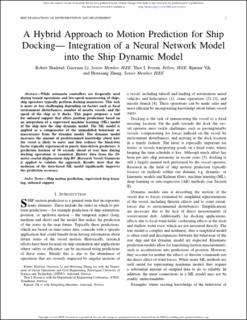A Hybrid Approach to Motion Prediction for Ship Docking— Integration of a Neural Network Model into the Ship Dynamic Model
Peer reviewed, Journal article
Accepted version

Åpne
Permanent lenke
https://hdl.handle.net/11250/2676731Utgivelsesdato
2020Metadata
Vis full innførselSamlinger
Originalversjon
http://dx.doi.org/10.1109/TIM.2020.3018568Sammendrag
While automatic controllers are frequently used during transit operations and low-speed maneuvering of ships, ship operators typically perform docking maneuvers. This task is more or less challenging depending on factors such as local environment disturbances, number of nearby vessels, and the speed of the ship as it docks. This paper proposes a tool for onboard support that offers position predictions based on an integration of a supervised machine learning (ML) model of the ship into the ship dynamic model. The ML model is applied as a compensator of the unmodelled behaviour or inaccuracies from the dynamic model. The dynamic model increases the amount of predetermined knowledge about how the vessel is likely to move and thus reduces the black-box factor typically experienced in purely data-driven predictors. A prediction horizon of 30 seconds ahead of real time during docking operations is examined. History data from the 29-meter coastal displacement ship RV (Research Vessel) Gunnerus is applied to validate the approach. Results show that the inclusion of the data-based ML model significantly improves the prediction accuracy.